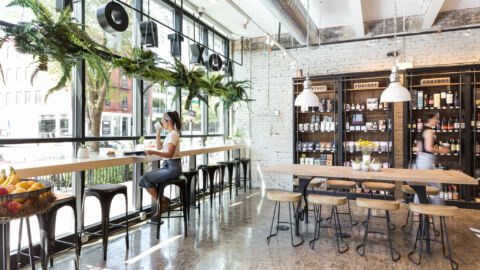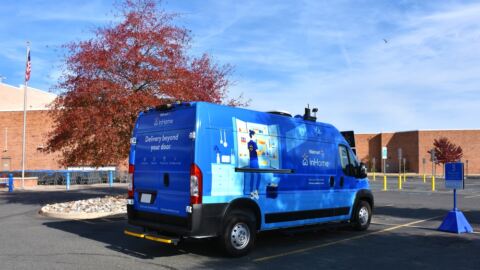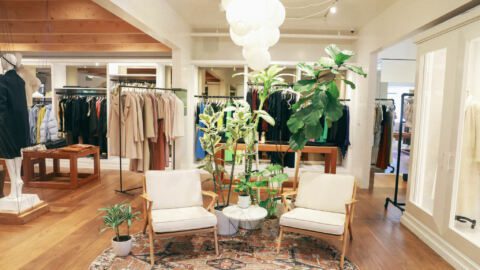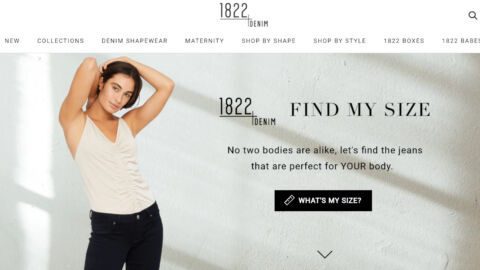 While many e-Commerce apparel retailers struggle with high return rates, Black Lapel has managed to keep its rate below 2% through a combination of questionnaires, one-on-one interactions with experts and post-sale follow-up. Black Lapel emphasizes education, developing loyalty by teaching potential customers about the benefits of custom suits.
While many e-Commerce apparel retailers struggle with high return rates, Black Lapel has managed to keep its rate below 2% through a combination of questionnaires, one-on-one interactions with experts and post-sale follow-up. Black Lapel emphasizes education, developing loyalty by teaching potential customers about the benefits of custom suits.
The growing omnichannel brand offers shoppers the custom tailored experience both online and at its showroom in New York City. In an exclusive Q&A with Retail TouchPoints, Derek Tian, Co-Founder and CMO of Black Lapel, details:
- How two finance professionals became retail clothing entrepreneurs;
- The process behind giving e-Commerce customers expertly-fitted suits;
- Why Black Lapel sometimes suggests post-sale alterations, even if the customer doesn’t request them, in order to perfect the “fit”; and
- The biggest marketing challenges the retailer faced as it found its feet.
Retail TouchPoints (RTP): How did you come up with the idea of Black Lapel, and how did you get started?
Derek Tian: My business partner Warren Liao and I were both working in finance after school, but we both were a little bit bored with our finance careers. We weren’t getting the kind of challenge we would find fulfilling.
As the idea of entrepreneurship started to take root, Warren actually first seized on this idea of custom clothing for men. When we first started thinking about this idea, we didn’t have a lot of options, even in New York, for clothing that was well-made, that fit really well and also didn’t break the bank. There were solutions that covered one or two of those, but never all three.
We set out to really re-create the experience of custom clothing. We wanted to try and bring the bespoke tailoring experience online to the masses in terms of access and price.
RTP: How did you develop the questions you ask potential customers? Have they changed based on customer feedback or other factors?
Tian: When we first started the business, as you can imagine we didn’t know too much about retail and the clothing business, so we learned a lot along the way. We did about a year’s worth of research and planning before we even launched the brand, testing the product and experience with friends and family.
Both during that initial period and subsequently, as we evolved from an e-Commerce-only brand to more of an online-and-offline model with our showroom in New York, we were able to have conversations with our early customers where we learned quite a bit about their motivations and the context that brought them to Black Lapel. We realized that there were a lot of questions and concerns that would consistently come up, and that we could preempt many of them. Over time those conversations accumulated and helped us evolve the standard set of questions that we ask, to better understand our customers’ contexts and be able to offer better service as a result.
RTP: How do the operations of your physical showroom inspire or impact your online offerings, and vice versa?
Tian: Our ambition was to start Black Lapel as a digitally native brand. From the very beginning, we were trying to build an experience online. When we designed our user experience we were always focused on how to help an online customer understand and navigate our process.
Then, because we’re based in New York, it became natural that we have a lot of customers in New York who wanted to meet with us and feel the products and fabric in person. As we started developing our first showroom in our coworking space, a lot of that initial in-person experience was driven by the same linear thought process that we used to build our first online experience.
However, as we started meeting with more and more customers, we developed those conversations into learnings. We realized there were a lot more opportunities for a dynamic experience in the showroom, to really understand the customers based on certain context-based questions and their responses. From there it led to a desire to adopt our showroom learnings and improvements into our online experience. Now, as we continue developing best practices in each channel, we do consciously try to extend them into the other channel, which drives a virtuous cycle of sorts.
RTP: Are there any other steps you take to try and match the personalization of a brick-and-mortar tailor?
Tian: One of the things that we originally didn’t anticipate online is just how many people didn’t necessarily understand what different design options meant for them individually, and how it would affect their garment. In the showroom, sometimes we’ll read their body language. If someone is looking less confident about a choice we’ll know about it. We don’t always have the benefit of knowing if someone is feeling confident online, and so over time, we developed better tool tips and help guides for different sections of the online buying process.
Beyond that, one of the things we’ve invested more in over the course of building this business is content marketing. We realized content was particularly valuable for our experience, and we needed to provide more education to men when they are going through this necessarily complex process. We have a publication that we developed called The Compass, and as you can infer from the name, it is really designed to give people direction on how to not just navigate our site, but learn to express themselves through clothing and style. This doesn’t replace [in-person interactions], but it does simulate the kind of context-based knowledge transfer that can happen with our stylists in our showroom.
RTP: What sort of questions do you ask when a customer has an issue with a suit’s fit and needs adjustments?
Tian: That process doesn’t always start when someone registers a complaint. Sometimes when customers receive their suits they may actually think the suit fits really well, but we may spot areas where there is room for improvement. The process typically starts where we ask for at least three photos, and if it’s a full suit we’ll ask for six. Those are front, side and back, typically taken with and without jacket.
Based on [photos taken by the customer], we’re able to offer a lot of very specific advice. Obviously there are additional qualitative questions we’ll ask in terms of comfort. A little bit of education, reviewing the photos and asking some questions allows us to triangulate into a final set of recommendations in case alterations are called for. And we don’t shy from making those recommendations, even when they result in alterations whose costs we cover as part of our fit guarantee. Ultimately getting to a better fit for a customer is something that results in a win-win for us. Not only is the customer happier and more likely to return for more suits, but they turn into a walking, talking billboard for Black Lapel.
RTP: What has been your biggest marketing challenge? Has it been difficult to explain the Black Lapel concept to customers or investors?
Tian: For people who aren’t familiar with custom, and that’s the majority of suit and shirt buyers out there, this is sometimes a foreign experience. Over time we’ve learned to develop better landing pages where we provide some of the education that’s needed to get the most out of our process. About how by going custom, you’re investing a little bit more time up front, but ultimately you end up with a product that fits you objectively better than what you can get off the rack at about the same price.
It’s challenging to get all that communicated in a quick way, because on a landing page you’ve got about five to 10 seconds to capture people’s attention. We’re still tweaking those landing pages, really trying to help people better understand on their first visit what Black Lapel is about and how we’re different from off-the-rack brands.
RTP: Who are your biggest influences? What are some of the lessons you’ve learned from them?
Tian: Tony Hsieh comes to mind, because I read his book Delivering Happiness right around the time I was still working in finance and thinking about moving on and starting a business. It became pretty formative for myself and my business partner because of a lot of the concepts Tony writes about in the book resonated — in terms of creating an amaze and wow type of experience for customers, and how you can apply that same concept with your own team internally to create happiness, satisfaction and purpose in their careers.
We’ve been fortunate to attract some really amazing employees onto our team, and I think one of the things we were lucky to have done very early in our business is we defined the core values of the business, adopting a few of the lessons from Tony’s book amongst other learnings and personal principles, into 11 distinct core values. Core value #1 just happens to be amaze and wow our customers with the best possible customer service. Core value #11, the other of these two bookends, happens to be have fun while you’re at work.
Our emphasis on core values came from this recognition that we wanted to not only do right by our customers but really add value to their lives, and to add value to the employees who work for us. And that if we wanted these core values to permeate our culture, we have to do it deliberately. It doesn’t happen by accident; it doesn’t happen just because we’re “good guys.” It happens through effort and really a very consistent application of those values through everyday decision-making, including how we hire and give constructive feedback. Tony’s book really helped with this recognition, and is probably something that anybody who is building a B2C business should read.













